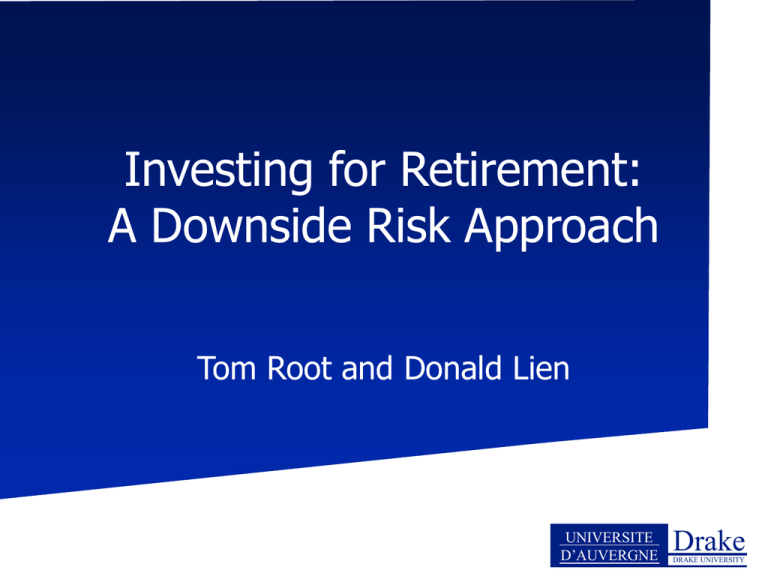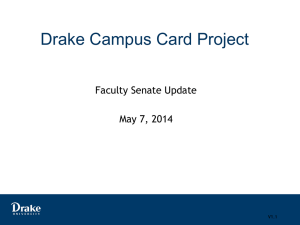PowerPoint Version of Allocating Assets in
advertisement

Investing for Retirement: A Downside Risk Approach Tom Root and Donald Lien UNIVERSITE D’AUVERGNE Drake DRAKE UNIVERSITY Motivating Questions UNIVERSITE D’AUVERGNE Drake Drake University When saving for retirement how should an individual choose the allocation of funds between risky and risk free asset? Can general guidelines be established to help in the allocation decision? Can empirical estimates using downside risk improve out understanding of the allocation decision? Academic Literature UNIVERSITE D’AUVERGNE Drake Drake University Samuelson (1969) and Merton (1969) Expected utility maximization of the consumption saving decision. Establish the end of investment period, then solve recursively for the allocation decision that maximizes the expected utility of consumption. Allocation decision that is independent of the investment horizon. Financial Planning Advice UNIVERSITE D’AUVERGNE Drake Drake University Decreasing emphasis on risky assets through time. The “100-age” rule The percentage of the portfolio placed in equities should be approximately equal to 100 minus the age of the individual. Retirement goal: Generate a given percentage of pre retirement income for a given number of years. For example 80% or pre-retirement income at age 65 or “80 at 65” Bridging the Gap UNIVERSITE D’AUVERGNE Drake Drake University Booth (2001) A Value at Risk Approach Individual attempts to contain the probability of failing to meet a given target wealth. “70 of 80 at 65” Achieving a 70% probability of generating 80% of pre-retirement income at age 65. The individual is concerned with the success or failure of meeting the target Value at Risk (VaR) UNIVERSITE D’AUVERGNE Drake Drake University An estimate of the amount of loss (or value) a portfolio is expected to equal or exceed at a given probability level. A Simple Example* UNIVERSITE D’AUVERGNE Drake Drake University Assume a financial institution is facing the following three possible scenarios and associated losses Scenario 1 2 3 Probability .97 .015 .015 Loss 0 100 0 The VaR at the 98% level would equal = 0 *This and subsequent examples are based on Meyers 2002 VaR Problems UNIVERSITE D’AUVERGNE Drake Drake University Artzner (1997), (1999) has shown that VaR is not a coherent measure of risk. For Example it does not posses the property of subadditvity. In other words the combined portfolio VaR of two positions can be greater than the sum of the individual VaR’s A Simple Example UNIVERSITE D’AUVERGNE Drake Drake University Assume you the previous financial institution and its competitor facing the same three possible scenarios Scenario Probability Loss A Loss B Loss A & B 1 .97 0 0 0 2 .015 100 0 100 3 .015 0 100 100 The VaR at the 98% level for A or B alone is 0 The Sum of the individual VaR’s = VaRA + VaRB = 0 The VaR at the 98% level for A and B combined VaR(A+B)=100 Coherent Measures of Risk UNIVERSITE D’AUVERGNE Drake Drake University Artzner (1997, 1999) Acerbi and Tasche (2001a,2001b), Yamai and Yoshiba (2001a, 2001b) have pointed to Conditional Value at Risk or Tail Value at Risk as coherent measures. CVaR and TVaR measure the expected loss conditioned upon the loss being above the VaR level. Lien and Tse (2000, 2001) have adopted a more general method looking at the expected shortfall The Original Financial Planning Model UNIVERSITE D’AUVERGNE Drake Drake University Let end of period wealth be given by: ~ WT (1 rf 1 )(1 rf 2 ) (1 rfT )T W (1 )(1 ~ r1 )(1 ~ r2 ) (1 ~ rT )W where rfi is the less risky return in period i ~ r is a the return for a risky asset, a random variable i is the % of the portfolio in the risk free asset Let G represent the target wealth then choose such that ~ Prob(WT G) 0 VaR model UNIVERSITE D’AUVERGNE Drake Drake University Booth’s (1999) model replaced the zero shortfall probability with a given level of probability, a. The goal is then to choose such that ~ Prob(WT G) a Expected Shortfall Model UNIVERSITE D’AUVERGNE Drake Drake University The individual should choose to minimize the target expected shortfall such that the shortfall cannot be more than a given percentage (b) of target wealth. ~ ~ E ( S ) E[max( 0, G WT )] bG UNIVERSITE D’AUVERGNE A More Formal Treatment Drake Drake University ~ Prob(WT G) a ~ E[max( 0, G WT )] bG The individual can satisfy both restrictions simultaneously The restrictions can be captured by the lower partial moment LPM of random variable X is characterized by two parameters: m, the target and n, the order of the moment where f( ) is the probability density function of X. Then m LPM ( X , m, n) (max[ m X ,0]) f ( x)dx n ~ ~ Pr ob(WT G) LPM (WT , G,0) ~ ~ E[max( 0, G WT )] LPM (WT , G,1) Empirical Estimations UNIVERSITE D’AUVERGNE Drake Drake University We attempt to use historical data to measure the past expected shortfalls across portfolio allocation, investment horizon, and target wealth assumptions. The Data UNIVERSITE D’AUVERGNE Drake Drake University Return Data is the monthly return reported by Ibbotson Associates January 1926 to June 2002. The risky return was proxied by the return on large company stocks and the risk free return by the return on long term government bonds. The returns were adjusted by the inflation rate reported by the BLS. Model Parameters UNIVERSITE D’AUVERGNE Drake Drake University Assume that an individual is currently 35 years of age and has $100,000 in savings. She is saving for the goal of reaching 70% of her pre-retirement real income of $50,000 per year or an annual annuity payment of $35,000 for 11 years (assuming retirement at age 65 and life expectance of 76). The real return on the annuity is assumed to be either 1%, 4%, or 7% producing target wealth estimates of $362,866.99, $306,616.68, and $262,453.60 respectively. Portfolio Allocations and holding periods UNIVERSITE D’AUVERGNE Drake Drake University 101 constant allocation portfolios beginning with 100% in treasuries and decreasing the percentage in treasures by 1% until reaching 100% in equities were calculated. The original investment period of 30 years was also deceased by one year until a holding period of one year was reached. Resulting in 30 different holing periods. Expected shortfall UNIVERSITE D’AUVERGNE Drake Drake University The shortfall for each portfolio was calculated as ~ max( 0, G WT ) The expected shortfall was generated by calculating the shortfall on successive portfolios of the holding period starting with each month in the sample (for those months with enough observations to satisfy the holding period). The average of the shortfalls is then reported as the expected shortfall Graph 1 Expected Shortfall for a Target Wealth of $306,616.68 250000 Expected Shortfall ($) 200000 150000 100000 24 16 8 0 32 40 50000 48 56 64 72 0 1 4 80 7 10 13 16 19 22 25 28 Holding period (years) 88 96 % of Portfolio in Equities 200000-250000 150000-200000 100000-150000 50000-100000 0-50000 Graph 2 Probability of Shortfall for a target Wealth of $306,616.68 1 0.9 Probability of Shortfall 0.8 0.7 0.6 0.5 0.4 0.3 0.2 0.1 0 1 4 85 7 10 13 16 90 19 22 95 25 28 100 Holding Period (Years) 80 75 70 65 60 55 50 45 40 35 30 25 20 10 15 % of Portfolio in Equities 5 0 0.9-1 0.8-0.9 0.7-0.8 0.6-0.7 0.5-0.6 0.4-0.5 0.3-0.4 0.2-0.3 0.1-0.2 0-0.1








